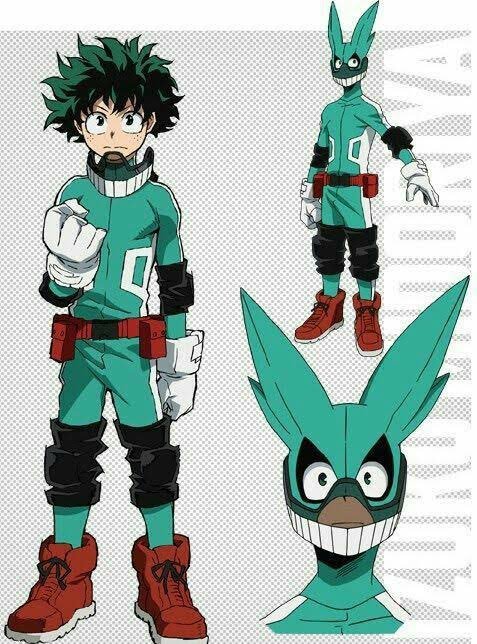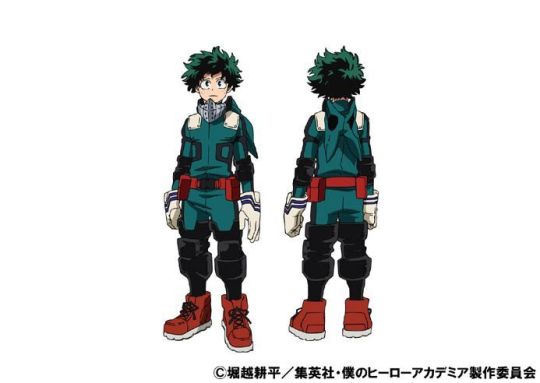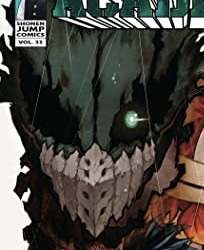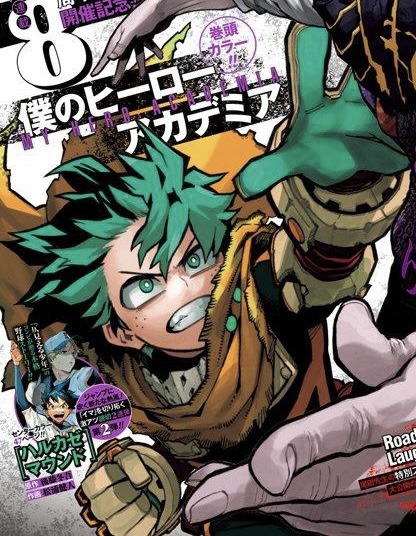#Horikoshi is a master at character design and using it to progress the themes of his story
Explore tagged Tumblr posts
Text
Deku’s hero costume and indicating tonal shifts within a story
This post builds on everything I mentioned in a previous one, and highlights the brilliance in Horikoshi’s character design. To be more specific, the brilliance in Deku’s design and his hero costume. I also want to start this post by saying that I am an artist myself, and while I’m always learning new things, I do have some knowledge and understanding of color theory and character design. Now, on the surface, Deku is purposely made to look as non-threatening as possible. He has very few sharp edges, his face is round, his eyes are round, and he has very curly hair. Furthermore, when you learn art and character design, one of the fundamentals is understanding how shapes affect the audience’s perception of the character. It’s a very complicated subject and shape language can be used in various ways, but to simplify: sharp edges and triangle shapes indicate harshness or intimidation, square shapes indicate stability and balance, and circles or round shapes indicate softness and gentleness. Izuku falls under the category of circle shapes and as previously stated without his hero costume, particularly in the beginning of the story before he loses more of his innocence, he looks relatively harmless. But let’s take a look at his first hero costume…

His first hero costume is very bright, with a mint green and white & red accents. Izuku has just begun his hero journey, and he has not had any pressure placed on his shoulders yet (except his need to not be useless and prove himself as having value due to his trauma from years of being looked down on for his quirklessness). He doesn’t know about the true history of one for all, or all for one. He hasn’t even encountered shigaraki yet. The use of highly saturated and bright colors are supposed to look odd on purpose, because this costume was designed by an bright eyed child who simply wants to be a hero, and not by a pro who’s been training for this moment for years. Furthermore, the light color scheme fits the idea of a positive protagonist who wants to goes into everything he does with an upbeat attitude. Think of Superman, who also have very saturated, bright colors in his design, and is another character is is known for his optimism. It should also be noted that the shaped in the hero costume are much sharper compared to deku himself. The stripe pattern, the utility belt, and elbow/knee guards are all very angular. This then can be taken in two different, yet connected directions. Deku, despite coming off as a harmless character, is able to function well as a hero right from the start because of his intelligence and ability to think on his feet. He’s an analyzer who takes his time to dissect his opponent’s weaknesses, and therefore one could say that he holds the capacity of being a very grounded character. Sound familiar? That is the square shape doing its job of conveying another aspect to Izuku that is best seen when he is in action as a hero. Thus, Izuku’s inner strength, reliability, and strong will are conveyed through square shapes in his costume. However, the angular nature of the same design patterns I’m mentioning, in addition to the pointy all might ears on his head, could also be hinting at Izuku’s ferocity in battle. I’ve already mentioned in a previous post I linked at the start of this but will link again just in case you don’t want to scroll up again lol, that Izuku has an intense, repressed inner rage that stems from his childhood trauma and self loathing. The sharp edges in his hero costume allude to this fact, but it can easily ignored since the color scheme is so bright and positive— his inner darkness can be overlooked by Izuku’s positive exterior. But let’s take a look at deku’s 2nd hero costume, and how it indicates a shift in Izuku’s character.

It should first be noted that Izuku only puts on this costume After the sports festival. The festival is where the process of an insurmountable amount of pressure being put on Izuku’s shoulders begins. He learns about the true legacy of One For All, he learns about his destiny to fight All For One, and he is told that he has to become the next symbol of peace and therefore has to have an “I am here” moment. All of these things are responsibilities that Izuku was never previously told about, and was never given any indication that he had to worry about. Thus, Izuku’s mental health begins taking a serious downward decline starting at this arc. This decline, or regression, follows him for the rest of the series all culminates in the vigilante arc. I won’t go into too much detail about that, because as previously stated I’ve already gone in depth about it, but I am mentioning this because this costume perfectly represents the beginning of Izuku’s regression. The color is much darker, and instead of white accents there are black ones. I cannot emphasize enough how big a deal it is for a superhero to change costumes to wear a much darker one. Spider-Man is the most well known case of this, as all of his darker toned or black suits often indicate a dark time in his life where he struggles with his inner rage and weight of responsibility. Does this sound familiar? Horikoshi loves heros such as Spider-Man, and that is why quirks such as blackwhip and danger sense are based off of Spider-Man’s abilities. It wouldn’t be much a stress to assume that is where Horikoshi also got the idea of making deku’s suit darker from. Therefore, Deku putting on his darker suit after he begins his slow downward spiral serves as foreshadowing to the audience that all is not well with our protagonist. While it may look better than his last, because he has become more mature and thoughtful about his choices, what it represents is not come-Worley positive. Furthermore, the hints of white, the remnants of his first costume, serve to show the remaining innocence he has left, or will have left by the time he stops wearing this version of the costume. It’s not much, buts it’s a beacon of hope that maybe it’s not too late.
By the time Izuku unlocks his shoot style, even more black is added to his costume in the form of his leg armor and his iron soles. He shifts to the shoot style after the summer camp and Bakugo retrieval arcs, which were very intense and traumatic events for him. He’s developing his own identity outside of allmight, which is positive, but the increasing amount of dark colors in his suit is concerning. His mental state is getting worse, he is continuing to enter a darker phase in his life, and it is happening at a slow enough pace that most other characters do not notice what is happening. Surprisingly, his costume does not change much for most of the future arcs. From a strictly character design perspective, this makes sense, as constantly changing a characters costume can make them less recognizable and thus alienate them from the audience. Plus, it’s simply easier to draw because the author will always know how the character is supposed to look. But, this could also be a sign of how Izuku tries even harder to put forth a positive persona while at the same time hiding what he is going through. We all know that things get worse before they get better, so let’s look at another costume change…


We don’t have many colored versions of Dark Deku yet, but from what we do have we can see how much work horikoshi put in his design to make it as menacing as possible. From the tattered costume, to the muddied colors, to Deku’s facing being hidden by a mask and cowl full of sharp edges, with only his pupils being visible. One thing about character design that I haven’t mentioned yet is the effect of showing/not showing a characters face. With characters, seeing their faces tends to make the viewers relate to them more, as we can more clearly see their facial expressions and make eye contact with them. Covering a character’s face purposefully creates a disconnect between them and the viewer. Think of characters who have something to hide, or struggle to be emotionally vulnerable. The personas of Batman vs Bruce Wayne, Spider-Man vs Peter Parker are comic book examples of characters who present themselves very differently as super heroes compared to their civilian forms, and wear masks that cover most of if not all of their faces. Furthermore, that is why in many Spider-Man movies the character will take off his mask a lot, even if it is mid-fight, because the audience needs to see his face in order to connect with him during those important moments.
Now with Izuku, as previously stated, we don’t see any of his face except his pupils while he is in his Dark Deku form. We are instantly disconnected from him. That is also why we’ve rarely seen deku wear his mask up until this point— even though we knew that it was always there as a part of his costume. The only other time that deku wears his mask for a significant amount of time is with his first costume, and when we is trying to simply imitate all might instead of trying to be his own hero (just as a lot of bright-eyed children would do when it comes to their innocent wish of wanting to be like their hero). He is trying to run from his emotions and who he is as Izuku Midoriya by hiding behind the persona of the Hero Deku, the 9th holder of One For All whose only purpose and source of value is to defeat All For One. Only when he takes the mask off at the end of the arc do we finally get to see genuine emotion from him. In addition, during this arc Deku is incredibly aggressive and vengeful. He has very little patience for his opponents. This is emphasized by the fact that there are almost no soft edges in his costume at this point. With it being torn to shred, there are shard and jagged edges everywhere you look. It may be a pain to draw, but it’s worth it for the effect it achieves. Any source of light colors are also gone. The white accents, which once represented the little innocence that Izuku had left as he continued to be plunged into the darkness of the hero system, are completely gone. His white gloved are now a dark brownish color, and even the dark green of his costume has become even darker. He’s so dirty that in many drawing of this form he is even drawn in all black, furthering the parallels between him and other comic book heroes with dark forms. He is the embodiment of despair and rage, thus cementing this costume as one that, in the words of civilians within the manga, “would never guess is a hero”.


Now this leads us to Izuku’s final costume change. Once again, we don’t have many colored pieces of this one and the ones we do have don’t show his entire body. However, we can notice some things about the color. Gran Torino’s cape is not longer just a thrown on addition, and instead Deku’s entire costume feels more cohesive and inclusive of the cape. Not only that, but the specific shade feels more like the color gold than a plain yellow. Gold is a color that often signifies success, and is commonly seen as the color of champions. Izuku is ready to finish this story, the legacy of one forand for all (lol, get it). But this time, he’s ready to do it with the help of his friends. That is what makes him a champion, instead of the villainous persona he had when he tried to complete OFA’s legacy on his own. Furthermore, the main color of his costume is much darker, and almost looks black. Izuku has been through a lot dating back to when he was a little kid, and he has a lot of trauma. He’s tried to run from that trauma all his life, but by the end of the vigilante/villain hunt arc, he finally is able to confront it in a healthy way with the help of his friends. He’s finally healing, and while he will never be able to get the childhood and innocence that he lost back, he can still find comfort and human connection as he moves toward a better future. Similarly, much of the lighter, more highly saturated colors on Deku’s costume will never come back. Gold is not a color often seen on children, and thus his costume is much more mature than his previous ones. While it may be bittersweet seeing our protagonist all grown up, the use of color and return to similar shape language signify that change is a part of life, and that at the end of the day a person will still be the same at their core. What matters is finding hope and success in the darkness.
So what does this all mean in the context of the story at large? Well, since Izuku is our protagonist and we go through the story via his perspective, as he regresses, and his costume changes, the story changes. We enter BNHA with a comedic and lighthearted story. There’s plenty of gags, pretty black and white interpretations of good and evil, and a decent amount of relatively laid back chapters/episodes. But during the arc that stain is introduced, Deku’s costume changes because of his own issues, and the story gets darker. His story gains more black accents, and the story becomes even darker. Deku has is dark deku form, and the story is the darkest it’s ever been. But once deku changes into his final costume, the story is still dark, but there’s a sense of hope that things will get better. Deku has hope that he can save Shigaraki. Thus, Horikoshi masterfully uses color theory and shape language to shape Izuku Midoriya as a character, his regression, and the increasingly dark tone of the story through the eyes of our protagonist.
#I had an epiphany and really wanted to write my thought process down even if this may seem obvious to some people#I just find it so interesting how deku’s costumes subvert the audience’s initial expections of him#Like the shift in the story perfectly coincides with the change from his first costume to his main one#And the shape language in the costumes say so much about who deku is as a person and hints to the audience about much of his hidden nature#Horikoshi is a master at character design and using it to progress the themes of his story#We need to pay attention to the little details such as as character design and title names more because everything has a purpose#We just need to be willing to see it#character design#bnha#mha#boku no hero academia#my hero academia#midoriya izuku#izuku midoriya#bnha spoilers#because I mention his latest costume#Bnha meta#bnha analysis#kohei horikoshi#Deku#bnha deku
117 notes
·
View notes